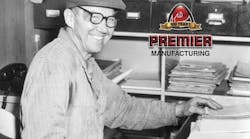Jep Enck, president of Enck Resources, believes the process of employee recruitment is one of the
most critical aspects of running a successful business.
And yet many companies treat hiring as a necessary evil to be done only when it is absolutely necessary.
In a National Truck Equipment Association (NTEA) webinar, “Recruitment Strategies for Success,” Enck said companies that are thriving and acquiring the “best of the best” have a budget for ongoing recruitment.
That includes:
• Advertising. “We’re finding more and more is direct, researching on LinkedIn or Facebook.”
• Employee incentives. “This is one of the most successful programs. Studies have shown that the biggest concern of employees regarding where they work is the quality of the people they work with. It’s important they have access to being involved in who those people are. When you use the bonus of money or cash for recruiting, studies are telling us that’s taking your eye off of the ball. The real incentive is intrinsic—an internal incentive to make sure you’re surrounding yourself with high-quality people on the team.”
• Headhunters. “You pay a flat fee or you pay a percent of the new hiree’s salary after a one-year period to make sure the hiring is working well within the company.”
Other recruitment strategies:
• Timing. “With employee expansion, if you’re trying to be in react mode, this will eliminate a lot of recruiting options such as advertising in a trade journal. But if you’re looking to hire someone directly, then that’s going to put more crunch on your time, and the quality of candidates available to you may be diminished.”
• Resources. “Who is responsible? Who is the person on your team in charge of maintaining a recruitment strategy and budget and making sure this does not slip through cracks? Most of my clients say they don’t keep a handle on this. Studies have shown and my experience has shown me that you should use people in the same age group.”
• Availability. “How many quality candidates are ‘out there’? We are now in an employers’ market over the country. Because of recent downturns, there are a lot of people looking for work. But my experience has been that this is very regional. If you’re in an area that’s growing, you are going to have a tight market for employees and some of the expenses might be travel expenses or moving expenses or even flying people in. What is your company’s reputation? How you recruit is basically by taking care of the people you have. Word-of-mouth advertising is the best. People say the favorite thing about their job is the people they work with, according to studies conducted every other year. The worst part of their job is the people they work with.”
What is the most important decision that management makes? Enck says he asks that question to the companies who hire him as a consultant. He said the most important decision is who gets to join the company’s team—and that’s why recruitment is so important.
“The cost of a wrong hire is so much greater socially and financially than putting a little bit more effort into the recruiting process and being more discerning,” he said. “If you don’t find the right person to put on the bus, keep looking. Settling is not a good idea. It usually works backwards for you.”
He said many companies don’t take time to record the cost per hire, but it could involve the following:
• Advertising fees.
• Job posting fees.
• Recruiting agency fees. “One of the highest expenses.”
• Employee referrals.
• Travel expenses. “Some of the best recruiting is done at The Work Truck Show. If I’m in a position where I’m looking for people, I’d definitely be working the floor and attending workshops. The best of the best do attend trade conferences and read trade journals.”
• Relocation fees.
• Internal recruiting costs. “Your labor and time.”
• Administrative costs (Human Resources).
“The cost of a bad hire is generally greater than trying to hold a team together until you get right person,” he said. “If you’re going to use a temporary agency, that’s a different story. If it’s more of an administrative and filing job, you might get someone locally.”
Recruiting sources:
• Where are people with these skills right now?
“One of the best things is to take a group that will be most likely to work with a new hiree and ask them to put together a list—even before advertising the opening—of the skill sets you’re looking for. The more specific, the better. The other side is the character traits you’re looking for. These are two distinct assets people bring to the table. There are people with tremendous assets but they might be hard to work with because they’re know-it-alls. There are a couple of tricks in looking for character. Is the cover letter immediately selling the potential employee or has he or she done any homework on the company itself? A self-starter will do that work, get on the website, and make calls to people at your company. Some people are phenomenal in interviews, but studies show that people lie in interviews.”
• What do they read and where do they congregate?
“Where do they hang locally in regards to golf courses or blues bars? It’s called guerrilla marketing. You go to where these people are.”
• Focused advertising—emails.
“It is not only going to keep the budget low, but it is extremely direct in its marketing. The old-fashioned headline of ‘Sales associate’ now might be, ‘Come join the best consulting team in Indiana.’ It’s more action-oriented. Having somebody with a marketing background is always a good person to have on the recruiting team.”
• Employee referral.
“There’s nothing wrong with small incentives. There’s nothing wrong with providing the possibility of dinner for four or a cash reward. It’s about putting someone on my team that will help me look good, and I want them to look good. People support what they help create. If people are helping in creating a new employee, they will help support that employee. Keep a record of past employees who have either retired or have moved on, and contact them. When an employee does leave, do not miss the opportunity to conduct an exit interview. If someone is moving forward or a spouse got transferred, take the time to take that employee to lunch and ask, ‘What did you enjoy most about working here? What did you enjoy least? What would you do differently if you were the manager? What kind of information will you be sharing about the company?’ ”
• Recruiting firms.
“There are two types: contingency firms, sometimes called headhunters, and they try to place a candidate and are only paid if they are successful; and retaining search firms that work on contract and are paid regardless of results.”
• Customers/schools/alumni groups.
“A customer is an excellent recruiting person as well. Let them know when you’re looking for new recruits. You can talk about superstars. A customer may even say he likes one of your competitor’s employees. A customer who is an end user has insights we might never see.”
• Flyers/radio ads.
“Radio is extremely specific today. Simply contact people in that field if you’re looking for specific listenership. Radio ads are a little expensive, but they pay big dividends in the right market, generally if you’re in a larger community.”
• Signs and billboards.
“Putting out a sign continues to work. There are a lot of people standing on the street, swinging a sign around. We are a very visual culture. Signs and billboard still work.”
• Competitors.
“Through customers, you can find about competitors. Some may be downsizing and you may want to scoop somebody up.”
• Job fairs/industry conferences.
“Those are places where the greatest networking is going on.”
• Retirement/religious/social groups.
“It’s always good to work the networks. They will help you not necessarily in identifying skill sets, but they are very good references for character.”
• Web page and other online sources.
“If you are actively recruiting, it may not be a bad idea to put it on your web pages. That will give people the idea that you are open. ‘Contact Jim Hamilton at NTEA,’ as opposed to, ‘Contact Human Resources.’ If you can give a specific name and number, it’s always better.”
• Business pages.
“Younger potential employees are getting a lot of news on the Internet now, but there are still newspapers, and the business section is never a bad idea.”
What do quality employees want out of their work situation? He provided the top results from a study involving middle management and VP levels of companies in Virginia:
• Sense of accomplishment.
• Opportunity to advance skills.
“It’s not to advance up the organizational chart.”
• Utilize their existing skills.
• Recognition for a job well done.
“Recognition means just talking to someone and telling them how much you appreciate their work. If you reward an Employee of the Month, research suggests you should quit doing it completely because it makes too many people Un-Employees of the Month and builds a sense of competition within the team. Today’s generations are more team-oriented as opposed to individual performance.”
• Opportunity for advancement.
“Is there a way to move up?”
• Adequate pay.
“I’ve been watching these studies for years, and adequate pay is always #6 through #10.”
• Fairness.
“Good news doesn’t travel as fast as bad news. If an employee feels they been treated unfairly, they will blog and get out and tell people. Just like the evening news. It opens up with what didn’t go well and then they will get into a human-interest story.”
• Pride in product.
“Obviously, you want a quality employee to have tremendous pride not only in the physical product, but the social product.”
• Congenial atmosphere.
“You want everyone to get along. Management is in charge of culture.”
• Benefits.
“Are you going to help me take care of my family?”
He said online recruiting involves:
• Start with the job.
“What does a person need to accomplish to be labeled successful? What skills does a person need to meet your expectations? How do you need them to behave?
• Work backwards.
“If you do the work with the team that’s going to work most directly with new hire, that works better than outsourcing to an HR department.”
• Strategy.
“It can be as simple as choosing which job board to post an ad on. It’s also about budgeting, timing, and resources. There’s nothing more embarrassing than having a web page advertising positions that have been filled. That gives you a bad reputation in the market. The biggest part of the strategy is who is in charge of the process.”
• Write the ad.
“In the headline, don’t just name a position. Ask a question. It’s more of a grabber. Then there’s the body that gets to specifics. Then there’s a call to action: asking people to pick up a phone or contact a person.”
• Track results.
“How many hits are you getting and where are you getting them from? Each time you do it, you will get better and better about key phraseology and which markets you want to go to. Social networking includes sites such as Facebook, MySpace, and Twitter. LinkedIn is the place for a professional job search. For me, if I’m in a position where it’s a one-man show, I’d be recruiting somebody who has the savvy to work with social websites.” ♦








